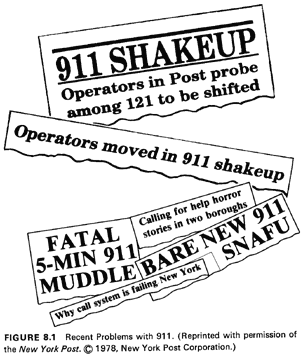


8.1.2 What-Design a Non-perfectly Working System?It is often difficult for an agency administrator to specify explicitly target levels for performance measures. This is particularly true when the target levels must be stated in probabilistic terms, thereby acknowledging that X percent of the time the system will not perform up to standards. A few years ago one of us was involved in a very short term (one person
month of total effort) study for scheduling telephone operators in a new
city-wide 911 system for New York City. The three-digit number 911 is now
being implemented throughout the United States as a standardized emergency
public safety number through which callers are linked to the local police
or fire department or ambulance service. However, at the time of this
study, it was a relatively novel concept. In New York's 911 installation,
queueing delays had become intolerable during certain periods of the day
and days of the week. Simple M/M/N queueing theory provided a reasonable
initial procedure for rescheduling the personnel to reduce significantly
the delays experienced. 2
However, to perform the rescheduling, it was necessary to
have the police commissioner (or his designated representative) state an
allocation objective of the following type: The commissioner's unwillingness to specify a positive value for P clearly rested in his uneasiness in acknowledging (and approving!) a system that functions imperfectly. Imagine a headline in a local newspaper, if the information were leaked that T = 15 seconds and P = 5 (assuming that 10,000 calls are received per day): "Police Commissioner Approves Excessive Delay in Answering 182,500 Police Calls This Year!" Therefore, not only are explicit statements of objectives difficult to elicit, but they are even more difficult when they contain a certain admission of failure as a result of the probabilistic nature of the system. This case has both a happy and a sad ending. Back at the drawing board, it was decided to redefine the problem as that of rescheduling the currently available person-hours to achieve the lowest possible mean queueing delay throughout all hours of the day. Thus, the problem became one of redeploying person-hours during relatively overstaffed periods to understaffed periods. To be sure, considerably improved values of T and P resulted from this procedure, but the police commissioner was never confronted with specifying them. The derived rescheduling was implemented in its entirety, approximately one month after the study was completed [LARS 72a]. The sad ending is associated with training of personnel. Approximately 8 years after the analysis reported here, insufficient training of 911 operators resulted in widely publicized inadequate response to several high-priority calls. Fully 121 operators were subsequently transferred to other duties (Figure 8. 1). Thus, the successful operation of any system requires continued professional training of personnel. This is just as true for model users as for 911 operators; Section 8.3 offers some suggestions for the training of model users. 
|


